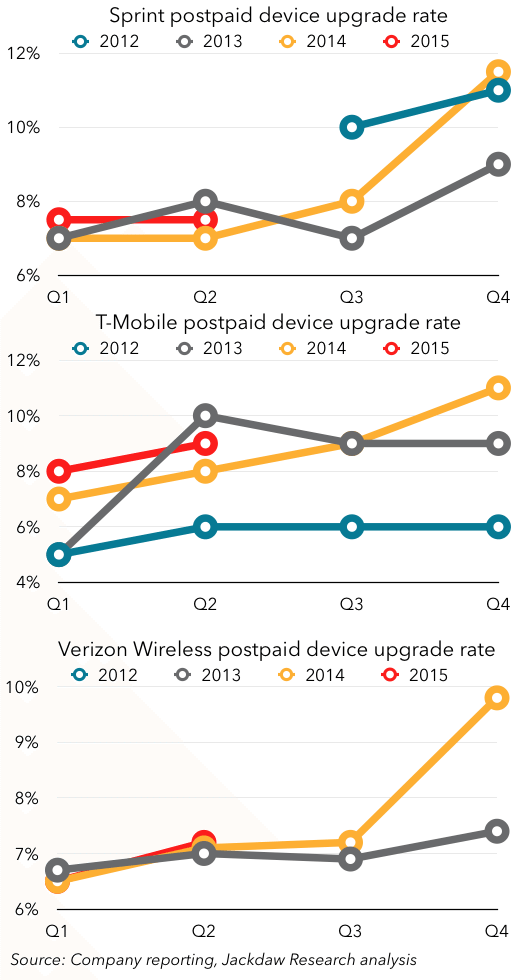I do regular quarterly presentations for some of my clients on trends in the US wireless market. As part of these presentations, I walk through the numbers reported by the major carriers and the implications for their businesses (several of these clients are smartphone vendors). At least two of these clients have now asked about reports they’ve seen that installment plans are reducing smartphone sales and slowing down upgrade cycles for smartphones. However, the reverse is true, as I’ll illustrate.
The argument for longer upgrade cycles is simple: on traditional plans, customers paid the same in monthly fees no matter where they were in the upgrade cycle, because service fees were decoupled from device purchasing. Now however, customers who have paid off their phones see a drop in the monthly fees. As such, some customers might wish to keep a device rather than upgrading because they could see lower bills until their next upgrade. That’s the theory. It makes perfect sense in theory and, the truth is, even the carriers didn’t know whether this effect would pan out in practice. Now though, we know what happened in reality.
Looking at upgrade rates
One of the best ways to look at all this is the number the carriers all report for the percentage of their postpaid base that has upgraded their phone in the quarter. Looking at long-term trends, it can be tricky to see the trends, especially since there’s a lot of cyclicality in this business. Below I’ve presented upgrade rates on an annual basis so that year on year comparisons are easier. Sadly, AT&T stopped reporting this metric for a while last year, so I’ve left them out.

The pattern isn’t 100%, but you can hopefully see from these charts that, with very few exceptions, carriers have had higher upgrade rates over the last few quarters than they did in the same quarters the year before. The effect is most dramatic at T-Mobile, the carrier which is furthest advanced in its shift to installment plans and also the carrier which has often had the highest upgrade rate. The evidence here is fairly conclusive – as subscribers move to installment plans, they’re upgrading more frequently, not less frequently.
Explaining faster upgrades
So, the reality has turned out to be the opposite of the theory. Why is this? Well, there are several reasons, but the most obvious is that, under a number of these installment plans, subscribers are actually eligible for earlier upgrades than they would have been in the past. However, the other thing is, even though in the past there was little incentive to postpone an upgrade, upgrading still cost a chunk of money every time, because you paid for a certain portion of the phone up front. So, an upgrade was a several-hundred-dollar transaction in the past for a premium device, whereas today it’s as simple as continuing the same monthly payment you’ve already been making. As Ben pointed out in his own piece recently, consumers tend to over-emphasize large fixed costs while downplaying smaller monthly payments (as with credit cards). Whether that’s rational (or healthy) or not isn’t the point: it’s the reality, and it’s benefiting smartphone vendors. However, as Ben also pointed out, it’s been benefiting Apple quite a bit more than Samsung and the other Android vendors.

This was beautiful Admin. Thank you for your reflections.